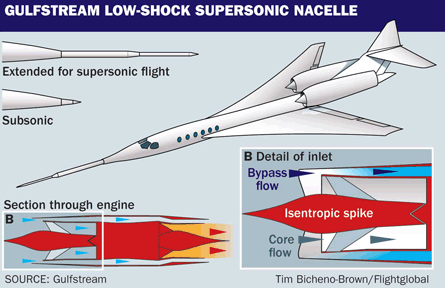Gulfstream and Aerion have begun to hone their designs for a supersonic business jet (SSBJ), reigniting aspirations for a programme launch or demonstrator build in the near rather than far term.
Pres Henne, Gulfstream's senior vice-president of programmes, has confirmed that the company "recently" tested a supersonic nacelle design on one engine of a Rolls-Royce Tay 651-powered Gulfstream IV on the ground.
The static run of a full-scale nacelle installation successfully proved that the sharp-lipped inlet, a design necessity, would not cause stability issues for the engine's fan by distorting the input flow. Initial indications are positive that the Tay 651 and nacelle combination "would be suitable for an experimental vehicle", says Henne, adding, "however we are not planning to [build a supersonic business jet demonstrator] at this time".
 |
|---|
The static engine test is one in a growing checklist of tests that encompass the tip-to-tail needs for an SSBJ, suggesting that the Savannah-based company is more serious about the project than it publicly admits. Along with nose-extendable supersonic spike tests with NASA, Gulfstream has tested external vision systems for zero-forward visibility cockpits and is working on advanced composite design processes for wings and fuselages.
Accompanying the technology is the regulatory and public acceptance angle, which Gulfstream is working through the International Civil Aviation Organisation, the US Federal Aviation Administration and NASA.
For the inlet, NASA is taking the next step with a series of supersonic windtunnel tests on a scaled model of the inlet in the Glenn Research Centre's 2.4-1.8m (8-6ft) facility. The model, referred to by NASA as an isentropic relaxed compression inlet, includes a series of curved vanes used to channel the bypass air.
Henne says Gulfstream has been performing preliminary designs that are "getting real close" to all of the requirements for an aircraft to meet perceived noise level of 70dB (70PLdB) while flying supersonic over land, a practice banned in Europe, the USA and elsewhere.
The noise threshold, which Gulfstream and NASA came to independently, can be compared to "closing a good car door or a refrigerator", says Henne. Meanwhile, ICAO is addressing the possibility of setting a threshold noise level for such flights through its committee.
The nacelle design, although not revealed, could be similar to a US patent that Gulfstream applied for in February. With the proposed nacelle, the patent states that an engine with 15,000lb maximum take-off thrust (67kN) and bypass ratio of 3:1 could power an SSBJ at a cruise speed of Mach 1.7. Those thrust and bypass characteristics closely match those of the Tay 651.
Reno-based Aerion too is focusing on nacelle characteristics in forthcoming windtunnel tests to check changes made during a series of engine nozzle noise screening tests more than a year ago, says Richard Tracy, director and chief technology officer for Aerion.
Tests at the United Technologies research centre in Hartford, Connecticut will include high-speed performance and low-speed runs for take-off noise. Aerion uses a gradient recovery type design for its inlet, which creates a shockwave normal to the throat of the inlet for decelerating the air flow to subsonic speeds. The company is proposing an eight-passenger, M1.6 aircraft for $80 million per copy, ready five years after a to-be-determined programme launch.
The planned engine, a custom designed variant of a Pratt & Whitney JT8-219, will feature a bypass ration of 1.7:1 and maximum take-off thrust of 21,700lb, although the engine will be flat-rated to a lower thrust.
Tracy says areas likely to need modification will include materials and coatings to handle higher temperatures for longer cruise durations, oil coolers and combustors for lower nitrogen oxides emissions. He says the engine will have legacy hydro-mechanical controls, but with an add-on digital interface to the cockpit.
Rather than asking for regulatory relief to overland flight rules, Aerion is proposing to operate at near M1 speeds over land and supersonic over water, its laminar flow wing providing optimal performance in both regimes.
Tracy says Aerion would generate around 0.7lb/ft2 initial shockwave overpressure on the ground compared with perhaps 0.3lb/ft2 for a quiet design similar to Gulfstream's technology.
Doug Nichols, Aerion chief financial officer, says the company has been collaborating in technical evaluations "of some depth" with airframers for the past eight or nine months in its search for a partner. He envisages the joint venture as a triad consisting of an airframer, financial participants and a tier 1 manufacturer. For its part, Aerion will provide its intellectual property rights and programme management assistance.
- All the latest news, images and video from EBACE 2010
Source: Flight International
















